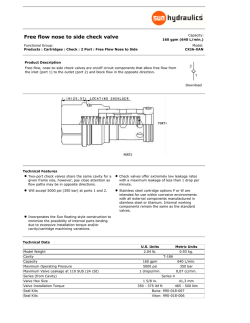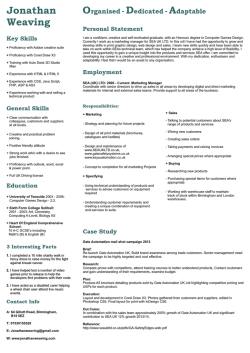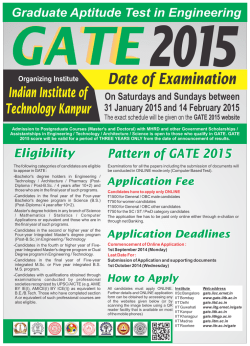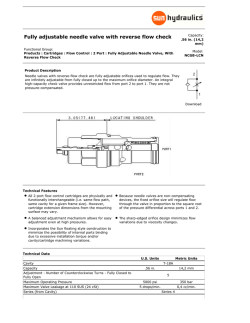
Knife Gate Valve Options
KNIFE GATE VALVES Actuation, Controls & Options INTRODUCTION Wolseley Industrial Group Valve & Automation, or WIGVA, is a premier valve automation center. We are a member of the Wolseley Industrial Group, the industrial division of Ferguson Enterprises, Inc. Since 1981, our facility has provided professional automation packages and fabrication solutions. We are experts in actuating quarter-turn and linear valves of all types and sizes, as well as fabricating custom components. With combined application and technical experience, we have been serving Pulp & Paper, Mining, Chemical, Food & Beverage, and general industrial businesses for decades. In 2011, our facility became ISO 9001:2008 registered. Quality and the continuing improvement process are evident in our products and service. Dedication to quality is what drives our facility to incorporate the latest technologies such as 3D CAD and CNC milling into our processes. ISO 9001 Registered Quality Management OVERVIEW Knife gate valves are a mainstay in many industries. Their narrow install footprint makes them attractive for installations with little face-to-face dimensions. There are many configuration types and styles in the market today. This document highlights many of the capabilities of WIGVA’s linear facility. The capabilities for knife gate valves are arranged in three main categories of Actuation, Controls, and Options. Actuation can solve many knife gate valve situations such as long stroke times, high stem torques and hand wheel rim pulls, inaccessible and remote locations, or needed integration into control systems. Most knife gate valves can be adapted to accept manual and automatic actuators. As more valves and processes become automated, controls are needed to integrate the valve package into the process control system. There are also many post production options available for knife gate valves to better match the valve to a specific application. TABLE of CONTENTS ACTUATION ................................................................. 3 Pneumatic Cylinders ........................................... 3 Hydraulic Cylinders ............................................. 3 Electric Actuators ................................................ 3 Gear Operators ..................................................... 3 Miters .................................................................... 3 Chainwheel Operators ..........................................3 Lever Operators ....................................................3 Rachet Operators ..................................................4 Square Drive Nuts .................................................4 CONTROLS ..................................................................4 Pneumatic Directional Control Valves ................4 Switches ................................................................4 Positioners ............................................................5 Position Transmitters ...........................................5 Speed Controls .....................................................5 Filter / Regulators .................................................6 Fail-Safe Systems .................................................6 Junction Boxes .....................................................6 Hardened Seats / Gates ........................................7 Lockouts ................................................................8 Alternate Resilient Seats ......................................8 Alternate Packing Materials .................................8 Deflection Cones ...................................................9 Gate Scrapers ........................................................9 Live Loaded Packing ............................................9 Medium / High Vibration Modification .................9 Bonnets ................................................................10 Stem Covers ........................................................10 Stem Boots ..........................................................10 Gate Guards ........................................................10 Non-Rising Stem Modification ...........................10 Stem Extensions ................................................. 11 Pedestals ............................................................ 11 Stem Guides & Couplers ....................................12 Gate Guides .........................................................12 Chest Liners ........................................................12 ABOUT COMBINATIONS ...........................................12 OPTIONS ......................................................................6 Back Seat Stops ....................................................6 Purge Ports ............................................................7 V-Ports ...................................................................7 Page 2 Phone: 503-287-8383 ~ www.WIGVA.com ACTUATION Pneumatic Cylinders – Pneumatic cylinders are offered in both double-acting and spring-return configurations. Sizing is typically based on 60 to 100 PSI compressed air or other compatible gas. Extended sizing ranges are available as needed. Pneumatic cylinders are available in both all steel and non-corrosive FRP tube designs. Gear Operators – Enclosed right angle bevel gear operators are available for knife gate valves. Gear operators provide mechanical advantage for easier knife gate valve operation. Options can be combined with the gear such as square drive nuts, chain wheel operators, or stem extensions. Hydraulic Cylinders – Hydraulic cylinders are offered in double-acting configurations. Heavy duty all steel cylinders are typically sized at 1000 PSI. Miters – Used in conjunction with bevel gear operators, a 1:1 miter can be used to reorient the input shaft of a gear operator for accessibility or addition of further options. Bevel Gear Operator Pneumatic Cylinder Hydraulic Cylinder Electric Actuators – Multi-turn electric actuators are available in many brands, voltages, enclosure ratings, and control schemes. Our preferred actuator brand is Auma, however Rotork, Limitorque, EIM, and others are also available. Bevel Gear with Miter Chainwheel Operators – For knife gate valves installed overhead, chainwheels are available to provide access. Various types of chainwheels can either replace existing valve handwheels or attach to it. Chainwheels can also be used in conjunction with bevel gear operators to provide easier operation of the valve. Galvanized chain can be supplied with the chainwheel provided the Chainwheel Operator drop is known. Lever Operators – Levers, or quick-opening levers, can be retrofitted to knife gate valves up to 8”. (Typically, the gate weight and force requirements are sizing factors.) Levers are a cost effective means to allow fast valve operation where powered actuators are not economical or feasible. They are ideal for mobile sites and remote locations where actuator power is not available. Lever Operator Electric Actuator Phone: 503-287-8383 ~ www.WIGVA.com Page 3 ACTUATION (continued) Ratchet Operators – In close-quarter applications that prevent the use of handwheels or gear operators, knife gate valves can be fitted with a ratchet operator for operation from the unobstructed side. Like lever operators, ratchets are limited to smaller size valves and torques. Ratchets typically use a custom machined drive nut and therefore not always the most economical solution. Square Drive Nuts – For knife gate valves installed below grade or otherwise inaccessible directly, the handwheel can be replaced with a square drive nut. The nut is typically driven by a tee-handled extension that can be custom made to accept the knife gate valve’s rising stem, or for valves retrofitted to non-rising stems. Ratchet Operator Square Drive Nut CONTROLS Pneumatic Directional Control Valves – Directional valves control the flow of air pressure to pneumatic actuators. Pneumatically actuated knife gate valves can include a control valve, and there are many types depending on the control system for the valve. These include, but are not limited to: Solenoid – A solenoid valve has a coil that accepts an electric signal for operation. Solenoid valves are the most common control valves used and are available in many voltages and enclosure ratings. Lever Operated – Lever operated control valves can be locally mounted with the valve and actuator package, providing manual operation of the actuator. Pilot Valves – A pilot valve operates from a pneumatic control signal generated from another device to operate the knife gate valve’s actuator. These are available when the pilot signal pressure is provided. Switches – Switches on knife gate valves are used primarily to indicate position or control other devices in the process when the valve is in a specified position. Switches are available in various voltage and enclosure ratings found in the following general categories: Mechanical – Mechanical switches are triggered by the movement of the valve’s gate. Proximity – Proximity switches use a magnetic field to operate and are triggered by a metallic “target” attached to the valve’s gate. Quarter-to-Linear – Both mechanical and proximity switches are also available in prepackaged quarterturn enclosures. WIGVA can adapt these devices to be driven by the movement of the gate. Mechanical Solenoid Page 4 Lever Operated Valve Proximity Quarter-Turn to Linear Pilot Valve Phone: 503-287-8383 ~ www.WIGVA.com CONTROLS (continued) Positioners – While knife gate valves are not typically recommended for flow control (modulating) applications, occasionally there is a need to control the stroke of the valve. Positioners are available to accomplish this task where the position of the gate is set based on a control signal. The general categories for positioners include: Pneumatic – One of the earliest and most common positioner types is the pneumatic positioner. They typically accept a 3-15 PSI control signal. Electro-Pneumatic – Similar to the pneumatic positioner, the electro-pneumatic positioner has the addition of a current-to-pressure, or I/P, module capable of accepting a 4-20mA electric signal. Digital – Also referred to as smart positioners, these devices include modern electronic “brains” that provide additional and automatic features over an electro-pneumatic positioner. Digital positioners are available to integrate a knife gate valve with many of today’s communication protocols. Position Transmitters – Similar to a position switch, a position transmitter can provide intermediate position feedback of a knife gate valve, typically in the form of a 4-20mA signal. These devices can be provided as stand-alone, or in conjunction with a positioner. Speed Controls – Knife gate valves with cylinders can include adjustable speed controls to set the cycling speed of the 4-20mA Position Transmitter actuator. Speed controls can be applied to the exhaust of control valves or oneway metering valves in the supply lines to the cylinder. Control Valve Exhaust Mounted Speed Control (typical) Pneumatic Positioner Electro-Pneumatic Positioner Digital (Smart) Positioner Cylinder Supply Line Mounted Speed Controls Phone: 503-287-8383 ~ www.WIGVA.com Page 5 CONTROLS (continued) Filter / Regulators – Used in conjunction with pneumatic cylinders, regulators can be provided to set the supply pressure leading to the actuator. They typically include a filter unit to ensure clean air supply to control equipment. Junction Boxes – Knife gate valves with many control devices on them can be a mess of wires or require multiple conduit runs. Yoke mounted junction boxes are available to consolidate electrical components into a single terminal strip, making the package cleaner and easier to connect to with a single conduit run. Fail-Safe Systems – Fail-safe systems provide pneumatic or electric back-up for actuation systems that potentially could lose motive force in critical applications. Filter / Regulator They’re traditionally designed to allow one or two strokes of the valve after loss of power. These systems require engineering based on the actuated valve’s control system. Fail-Safe Systems Junction Boxes OPTIONS Back Seat Stops – Primarily for unidirectional knife gate valves, back seat stops can be added in applications where there is low pressure differential (less than 35 PSI) across the valve or where reverse pressure could unseat the valve. Two stainless steel blocks are welded to the valve’s upstream port, typically at the 3 and 9 o’clock position. Back seat stops help maintain shut off by holding the blade close to the seat and prevent blade deflection in severe reverse flow. Back Seat Stops Page 6 Phone: 503-287-8383 ~ www.WIGVA.com OPTIONS (continued) Purge Ports – Knife gate valves are often used in harsh applications involving suspended solids or other material that can collect in the bottom of the valve or in the chest area. These solids can potentially interfere with the proper operation of the valve. Purge ports can be provided at various points on the valve around the seating and chest area. Water, gas, or sometimes even steam is piped into the purge ports to flush material out of critical areas and send it downstream of the valve. Flushing usually occurs during cycling of the valve. To make the connection of purge ports easier to install, they can be pre-plumbed together into what is called a halo, with all stainless steel components. Hardened Seats / Gates – Knife gate valves have various seat and/or gate hardening options available. Hardening of the seat or gate is an option to extend the life of these components in corrosive, abrasive, or solids applications where improved cutting action is required. Hardening options include: Hard-Chrome Plating – Gates can be coated with industrial hard-chrome plating to a minimum thickness of 3/1000”. Corrosion, abrasion, and impact resistance are good. Stellite-Faced – Both gate cutting edges and metal seats can be hardened with Stellite 6®, an alloy of cobalt-chromium and tungsten. Stellite is weld overlaid on the components and then machined to a finish of no less than 50/1000” thick. Stelliting provides good abrasion resistance, but excellent corrosion and impact resistance. It is particularly useful in applications where improved cutting action is needed. 17-4 PH Gates – Standard stainless steel gates can be replaced with 17-4 PH stainless gates. 17-4 PH stainless steel is a chromium-copper precipitation hardened stainless steel that provides good abrasion, impact, and corrosion resistance. It has a higher tensile and yield strength than standard stainless steel gates. Purge Ports Purge Ports with Halo V-Ports – A knife gate valve can be used for metering (modulating) service by modifying the round port to a v-notch port. Standard round port valves in the near close position create a crescent shaped opening that can easily be clogged by suspended solids. The addition of a v-port can greatly reduce the chance of clogging while also providing a little more linear flow control characteristics. V-port installation is a body modification; therefore the valve is required for completion V-Ports (i.e. – no field mount kits). Phone: 503-287-8383 ~ www.WIGVA.com D2 Tool Steel Gates – Standard stainless steel gates can be replaced with D2 tool steel gates. D2 tool steel is a high-carbon, high chromium, air-hardening steel. It provides excellent wear resistance and toughness in abrasive applications, but not as corrosion resistant. Hard Chrome Plated Gate Stellited Seat & Gate 17-4 PH Stainless Steel Gate D2 Tool Steel Gate Page 7 OPTIONS (continued) Lockouts – Knife gate valve lockouts are available in several configurations, including: Handwheel Bolt - The preferred method is the handwheel bolt lockout. A stainless steel welded on bolt cartridge can be raised or lowered easily to block the handwheel and is padlocked in either position. Alternate Resilient Seats – Knife gate valves with resilient seats can often have alternate materials to suit specific applications. While many seats can be proprietary in nature, others can easily be changed out if specific dimensions are known. Gear Plate – Gear operated knife gate valves can also be provided with lockout plates. The plates are padlockable, reventing handwheel movement. This configuration reduces the amount of force being applied to the lockout device. Handwheel Cable – Similar to the handwheel bolt, a handwheel cable lockout uses a steel cable that feeds through the handwheel and a hole in the valve’s yoke. The looped ends of the cable are padlocked together. Gate Pin – A gate pin lockout is a steel pin that slides through yoke mounted lugs and over or through the gate itself, preventing gate movement. The pin is padlockable. The valve can be configured for close, open, or both lockout positions. BUNA Seat EPDM Seat Food Grade EPDM Seat Viton Seat Ball Valve Loutout – Stainless steel padlocakble ball valves are mounted in the supply lines to cylinders. Closure of the valves locks the cylinder in its last postion. Gear Plate Handwheel Bolt Handwheel Cable Page 8 Gate Pin Ball Valve Lockout Alternate Packing Materials – Like seat materials, packing materials can also be application specific. Except for proprietary seals or anti-extrusion components, packing material tends to follow standard or metric typical dimensions. Packing materials that address chemical, pH, or temperature requirements are available. Pure TFE Packing Graphite Yarn Packing Phone: 503-287-8383 ~ www.WIGVA.com OPTIONS (continued) Deflection Cones – Many knife gate valves, particularly uni-directional type, have a stepped seat design. While the stepped seat decreases clogging around the seat area, when the valve is open the seat faces upstream flow, exposing the seat to potential abrasive material. A deflection cone can be provided that, when mounted between the valve and upstream flange, can redirect flow away from the seat and towards the center of the flow path. Ni-Hard, a nickel-chromium cast iron alloy, is a common deflection cone material used in harsh applications such as mining. Other materials are also available. Live Loaded Packing – Knife gate valve applications such as thermal or high cycling, or vibration situations can cause the packing gland bolts to loosen. In these situations, live loaded packing can be provided. Extended packing gland bolts or studs are used in conjunction with stacked Belleville washers. When tightened, the washer stacks impart a force into the gland, maintaining compression on the packing. Live loaded packing requirements vary by manufacturer; therefore the valve may be required for completion. Deflection Cone - Cutaway Live Loaded Packing Deflection Cone - Assembly Gate Scrapers – To enhance protection of the valve packing and maintain packing seal, a PTFE or metal gate scraper can be installed in the base of the packing well. The gate scraper can clear abrasive and sticky material from the blade as the valve opens, minimizing wear to the packing. Medium / High Vibration Modification – Knife gate valves installed in medium to high vibration conditions can cause components to loosen, leading to premature wear and failure. Medium vibration is defined as oscillation ranging from non-visible to 1/16” movement, and high vibration from 1/16” to 1/8” movement. Valves can be fortified against this vibration using nylon lock nuts, thread lockers, or tack welds where applicable. Since this is a post factory treatment, the valve is required for completion (i.e. – no Medium/High Vibration Treatment Points field mount kits). Stainless Steel Gate Scraper Phone: 503-287-8383 ~ www.WIGVA.com Page 9 OPTIONS (continued) Bonnets – Many knife gate valves can be retrofitted with a bonnet. A bonneted knife gate valve allows for buried service, provides internal corrosion resistance from corrosive environments, and improved stem sealing. Bonnets are typically fabricated and require the original valve for completion (i.e. – no field mount kits). Materials and pressure ratings must be determined at time of quote. Gate Guards – An OS&Y knife gate valve typically has the gate and stem exposed above the packing gland. These moving parts, especially on actuated valves, can be a safety concern where people are present. Fabricated gate guards of sheet or expanded metal are available that attach typically to the valve’s yoke and surround the gate and stem area. Valve dimensions vary by manufacturer; therefore the valve is required for completion (i.e. – no field mount kits). Stem Covers – To protect rising knife gate valve stems from debris and impact, a stem cover can be provide that attaches to the hand wheel or the top of a gear operator. This fabricated component often requires modification of the valve; therefore the valve is required for completion (i.e. – no field mount kits). Gate Guard Non-Rising Stem (NRS) Modification – For overhead space limited applications, knife gate valves can typically be retrofitted to a non-rising stem. In this configuration, the stem is driven through a gate mounted nut. NRS adaption is a major fabricated top works retrofit; therefore the valve is required for completion (i.e. – no field mount kits). Bonnetted Knife Gate Valve Handwheel Mounted Stem Cover Stem Boots – Particulate debris in the environment can attach to knife gate valve stems or actuator piston rods, hastening the wear of drive sleeves and rod seals. Stem boots, a bellows of rubber or reinforced fabric, can be retrofitted to protect stems and piston rods. A stem boot retrofit may require the elongation of the valve’s yoke or stem, therefore the valve is required for completion (i.e. – no field mount kits). Page 10 Gear Mounted Stem Cover Non-Rising Stem Adaption Stem Protection Boot Phone: 503-287-8383 ~ www.WIGVA.com OPTIONS (continued) Stem Extensions – For knife gate valves installed below grade, grates or cat walks, where operation is required from an elevated location, WIGVA can provide stem extensions. Extensions come in a variety of configurations. The two main categories are: Rising Stem – In this configuration, the valve’s threaded stem is moved to, driven by, and supported from, the extension end. A reach rod extends from the clevis connection on the valve to the threaded rod. Consideration must be given to the type of drive used and how it is mounted because the extension end must support the weight of itself as well as the thrust requirements of the valve. Additional supports or reach rod guides may be needed. Drives can be ratches, handwheels, bevel gears, or electric actuators. Pedestals – Unless a stem extension is self-supporting, a pedestal is often used to raise the extension’s drive to sufficient operator height. Pedestals can be provided for floor mount, offset (wall) mount, or grate (catwalk) mount. As an option, pedestals can be supplied with position indication. Consideration should be given to where the valve and drive forces are to be supported to ensure a pedestal configuration doesn’t require additional support. Non-Rising Stem – For this configuration, the threaded stem remains with the valve. A nonrising stem adapter or torque tube is attached to the valve’s drive sleeve and from that the reach rod extends. Primary support for the system is at the valve. Depending on the extension’s size and length, additional guides or support may be needed. The extension end only needs to support the drive requirement of the valve. Position Indicator Style Non-Rising Stem Extension Rising Stem Extension Pedestal Phone: 503-287-8383 ~ www.WIGVA.com Page 11 OPTIONS (continued) Stem Guides & Couplers – When stem extensions are very long, or need to be assembled in sections, guides and/or couplers may be needed. Long extensions that transmit thrust force can potentially cause the reach rod to buckle; guides support the rods from this type of side load. Couplers allow long reach rods to be assembled in sections so that extensions can be fed through floors, walls, catwalk, and guides. Guide & Coupler Gate Guides – Gate guides help optimize shut off on unidirectional knife gate valves or otherwise provide support for gates, especially on larger valves, or valves installed in the horizontal rather than vertical position. Guides can be in the form of gate or center line buttons, or gate side supports. Gate guides are a body modification; therefore the valve is required for completion (i.e. – no field mount kits). Chest Liners – Knife gate valve chest liners are inserts that fit between the body and gate and often take up one row of packing. Chest liners provide additional seal to keep pipe line media from contaminating the packing area. They also provide gate support and alignment for larger valves, or valves installed in the horizontal rather than vertical position. Chest liner requirements vary by manufacturer; therefore the valve is required for completion (i.e. – no field mount kits). PTFE Chest Liner Chest Button Gate Guides ABOUT COMBINATIONS Many options and accessories can be combined as conditions require. For example, a knife gate valve may require a bevel gear operator with a miter, or back seat stops with a handwheel bolt lockout or a non-rising stem extension with two inch operating nut. Combinations may have more than one solution as well. For example, a knife gate valve may be installed in a vault, requiring both a gear operator and stem extension. Option one is to install the gear operator with miter on the valve and extend the low torque input shaft. Option two is to extend the high torque stem to a top mounted gear. Whatever the combination is, our facility has the experience and capability to develop the right package needed. Contact our sales associates regarding your specific application needs. © 2014 - WIGVA. All rights reserved. Wolseley Industrial Group, Valve & Automation (WIGVA) is a member of Wolseley Industrial Group The contents of this publication are presented for information purposes only, and while effort has been made to ensure their accuracy, they are not to be construed as warranties or guarantees, expressed or implied, regarding the products or services described herein or their use or applicability. All sales are governed by our terms and conditions, which are available on request. We reserve the right to modify or improve the designs or specifications of our products at any time without notice. ID: KGV_Opts14 Ver. 09/2014
© Copyright 2025





